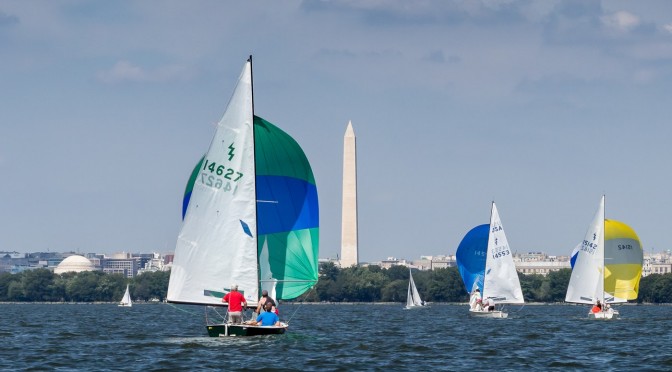We had a great turnout for Spring Series #3. Unfortunately the weather was a bit less cooperative, providing us summer drifting conditions. A determined RC eventually got us off on a W2 race in a very light and patchy southerly after numerous attempts to find breeze and set a course. I know that at least a few boats were glad that we got that race though, as Sunday saw Lisa-Marie Lane earn her first ever bullet in the Lightning fleet. Staying patient, staying focused on the conditions, and being mindful of finding clear air appeared to be key for her & team As You Wish. Lisa-Marie was followed closely by Kristen Burke (skippering Progressive Plastics) in 2nd, and I’m told that this might mark the first time in Fleet 50 history that we had female skippers finish 1-2 in a PRSA series race. Congrats all around!
I was finally out for my first racing of the spring season aboard Lightning #14592 (sailing with regular crew Piercarlo and welcoming new/interested crew Claudio Purificato aboard) and we quickly relearned some of the cardinal lessons of light air sailing: find clear air (especially after the start), find the next patch of breeze, and mind the current. I was caught to windward of a pack of boats on the start, which was a mistake. Groups of boats go very slow together in light wind, and we saw that firsthand. We were too close to bear off and gain speed; tacking away killed the speed we had, so we were fighting back from the rear from the start.
Piercarlo and Claudio did a great job finding breeze and clear air up the first leg, though, so we were in the hunt at the top mark. The incoming tide was a big factor on the afternoon, and I saw numerous boats in different classes take themselves out of the race by cutting it too close to the windward mark. By the time you got clear and did circles you were at the back of the pack. We all did a good enough job with the current and we maximized our gains on the few easterly puffs that came through such that we were able to reel in many, but not all, of the 11 Lightnings on the course.
After the racing we all enjoyed a great BBQ around the grill. Keep reading for the scores and for some more details from the racing. Please feel free to offer up your own comments here or on the PRSA email listserv!



